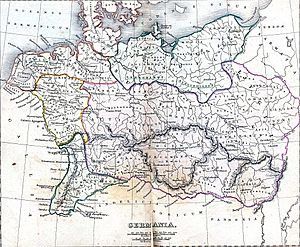Silingi facts for kids
The Silingi were an ancient Germanic tribe. They were part of a larger group called the Vandals. The Silingi once lived in a region known today as Silesia. Many people believe the names Silesia and Silingi are connected.
Contents
History of the Silingi
Early Mentions of the Tribe
The Silingi tribe was first written about in the 2nd century. A geographer named Claudius Ptolemaeus mentioned them. He said they lived south of the Suevic Semnone tribe. They were also north of the Carpathian Mountains. This area is now part of Silesia.
Ptolemy described their location:
Back below the Semnones the Silingae have their seat, [...]; and below the Silingae the Calucones and the Camavi up to Mt. Melibocus, from whom to the east near the Albis river and above them, below Mt. Asciburgius, the Corconti and the Lugi Buri up to the head of the Vistula river.
Some experts think the Silingi might be the same as the Nahanarvali tribe. Another writer, Tacitus, mentioned the Nahanarvali. He placed them in a similar area where Ptolemy said the Silingi lived. The Nahanarvali were known for guarding a special place for twin gods.
Moving West with the Vandals
Around the year 400, the Silingi and other Vandal groups started moving west. They were pushed by another powerful group called the Huns. In 406, they crossed the Rhine River into a region called Gaul. Then, in 409, they crossed the Pyrenees mountains into Iberia (modern-day Spain and Portugal).
The Silingi settled in a part of Iberia called Baetica. Another main Vandal group, the Hasdingi, settled in Gallaecia. Later, the Romans and their allies, the Visigoths, attacked the Silingi. Because of these attacks, the remaining Silingi joined the Hasdingi Vandals.
Journey to North Africa
In 428, the Vandal leader Genseric took over. He led the Vandals, including the Silingi, to North Africa. There, they created their own Vandal Kingdom. Their main city was Carthage. This kingdom lasted for many years. However, it eventually fell apart in the Vandalic War of 533–534. The Eastern Roman (Byzantine) Empire took back the land.
After the Silingi left, new Slavic tribes moved into Silesia. These new groups slowly replaced any Silingi who might have stayed behind.
The Region of Silesia
How Silesia Got Its Name
Some historians believe the name of the region Silesia comes from the Silingi tribe. They think the tribe's name gave the region its identity.
However, there is another idea about the name. It might come from an old Polish word, "Ślągwa." This word means "humid" or "damp." This could describe the weather in the region.
Mount Ślęża: A Special Place
The name Silesia is also thought to come from a river or a mountain. These are now called the Ślęza River and Mount Ślęża. Mount Ślęża was a very important religious place for the Silingi. It is located south of the city of Wrocław.
The mountain was a sacred spot even before the Silingi. People from the Lusatian culture worshipped the sun there as early as 1300 B.C.
Legacy of the Silingi
A student group called Corps Silingia Breslau exists today. It started in 1877. Currently, it is located in Cologne, Germany. Its full name is Corps Silingia Breslau zu Köln. This group keeps the name of the Silingi alive.
See also
 In Spanish: Silingos para niños
In Spanish: Silingos para niños
- List of ancient Germanic peoples
- Fredebal
- Silesians
- Silesian tribes


